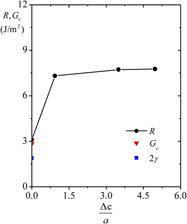Published online by Cambridge University Press: 19 April 2016

The fracture behavior of a single-crystal Al-nanoplate with an edge crack under tensile loading was simulated using a molecular statics technique to evaluate crack growth resistance in Al. The crack length was determined using a stiffness method. A parabolic function fitted from simulation results was used to predict the crack length from the stiffness value extracted from unloading curves. Based on energy considerations, crack growth resistance was calculated. Crack growth resistance rose sharply in the initial stages of crack growth, and with an additional crack extension, it increased gradually to converge to a constant far exceeding the fracture toughness predicted by the Griffith criterion. This trend in the crack growth resistance curve was closely related to the amorphous zone formed at the crack tip after the onset of crack propagation.